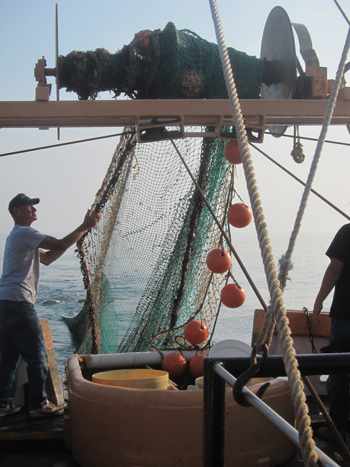A Generation on the Gemma: A Tribute to Capt. Bill Klimm

Capt. Bill Klimm is exactly the kind of guy you’d think of when you hear the word “fisherman,” with his dark blue jeans, plain grey shirt, and a ball cap shading his slightly sunburned face. His eyes are a startling shade of blue, so vivid it was like all the time he spent on the ocean suspended the colors within him.
Klimm retired this week as captain of the Gemma, the Marine Biological Laboratory (MBL)'s collecting boat, after 23 years at the helm.

It all started with his father, Capt. Henry W. Klimm. In 1942 Henry Klimm, along with his wife and 6-year-old Bill, moved from Hyannis to Woods Hole to take a position as a commercial fisherman. As they packed up their bags and made their way west along the Cape, they couldn’t have known the lasting impact they’d have on the understanding of an ecosystem.
Henry Klimm quickly became a local legend around Woods Hole, captaining a number of fishing vessels. You could hardly mention his name without someone pointing out his contributions to Fishes of the Gulf of Maine (1953) by Henry B. Bigelow and William C. Schroder, which became the main guide to fishes in the Gulf of Maine. Henry Klimm is still recognized for his contributions to modern knowledge of local marine fisheries. But the legacy didn’t end there, as his son Bill carried on the tradition.
“By the time I was 12, maybe 13, I had gone to work on [my dad’s] boat in the summertime,” Bill Klimm recalls. By the time he graduated from Lawrence High School (now Falmouth High School), he was a natural when it came to navigating his way around a boat.
“I was living here in Falmouth, and a construction company had a little towboat. I was going out to work on the towboat and the captain asked, ‘Do you wanna drive?’” Bill was up for the challenge. “[The captain] said ‘Eh, you can’t’ and I said, ‘Yeah, I can, watch.’”
That was the first time Bill Klimm captained a vessel. He would continue to work on commercial fishing boats until his dad asked him for a hand on deck of the MBL collecting vessels, the Loligo and the Gemma. Previously a commercial fisherman, on the Gemma Bill transitioned to obtaining specimens, specifically the longfin inshore squid, for scientific research.
 Bill Klimm brings up the collecting net on board the MBL's vessel, The Gemma. Credit: Laurel Hamers
Bill Klimm brings up the collecting net on board the MBL's vessel, The Gemma. Credit: Laurel Hamers“The squid is prized for its single axon, its main nerve, running down the length of its body. It’s one of the largest axons in the animal world. People doing research on nervous system functioning love the squid for that reason,” says Bill Mylett, Bill Klimm’s boat mate who is now senior boat captain/marine operations supervisor at MBL.
So what is a day out on the Gemma like? “We catch the 6:30 bridge in the morning,” Mylett says, referring to the Water Street drawbridge that allows boat passage between Eel Pond and Vineyard Sound. “It takes us about an hour to an hour and a half, depending on the tide, to get to the western end of the sound, right near Martha’s Vineyard. Not far from the beaches there, we trawl.” Trawling involves casting a long net off the stern of the boat. The net drags across the seafloor as the boat moves along, collecting squid and fish along the way.
Depending on the day and how many squid need to be caught, the Gemma crew does between four and seven trawls. These are long days, often amounting to 10 hours of work. But when I ask Bill Klimm what a day out on the water is like, he answers simply. “Go out, hope the weather’s good. It’s not much different than going to the beach. You have to work, that’s all.”
The work they do contributes to research with marine animals that can advance our understanding of human biology and disease. While Klimm may seem like just a fisherman providing samples for research, his depth and insight go far beyond the surface reveals. Bret Grasse, MBL’s manager of cephalopod operations, affirms this. “The knowledge and experience that comes with running and captaining a boat like that is something you can’t teach.”
“First of all, Bill is just a really nice guy,” Mylett says, then leans back in his chair and looks up at the ceiling, blinking a few times. “Sorry, I’m actually choking up a bit. I mean, my goodness, Bill is 82 years old. To be doing this kind of work -- it’s physical work.”
Mylett hardly has to say more for me to get the picture. All around, Bill’s colleagues see him as an inspiration.
“I think Bill’s role at the MBL is a testament to the institution’s foundation in tradition and its longstanding history,” Grasse says. “Bill’s multigenerational commitment and contributions to the MBL are extremely appreciated, and is what MBL’s all about.”
Hannah Knighton is a masters student at John Hopkins University and an intern with the MBL’s Cephalopod Breeding Program.